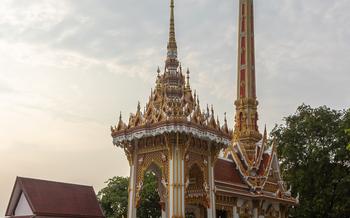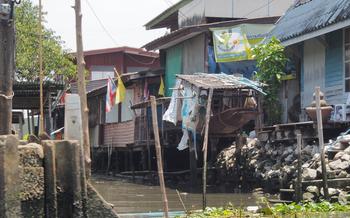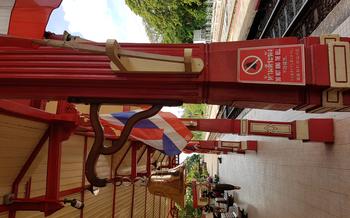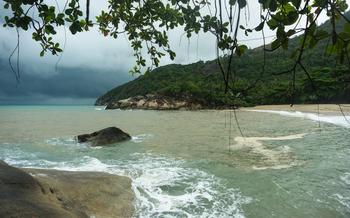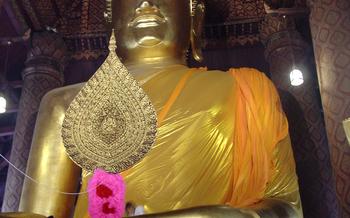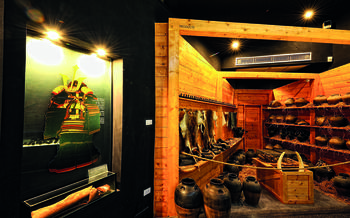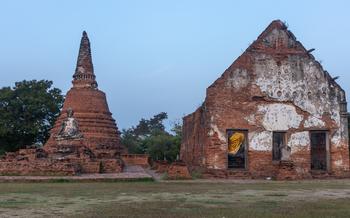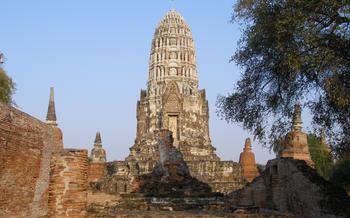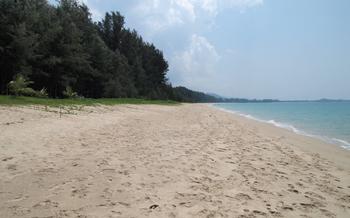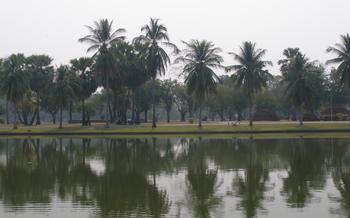
Ban Laem District Mangrove Forest
- Ban Laem District Mangrove Forest: A Natural Paradise
- Exploring the Mangrove Forest by Boat
- Kayaking Through the Mangroves
- Renting a Kayak and Where to Launch From
- Recommended Routes for Kayakers
- The Unique Experience of Kayaking Through the Mangroves
- Things to Keep in Mind When Kayaking
- Birdwatching in the Mangrove Forest
- Hiking Trails Through the Mangrove Forest
- Picnicking in the Mangrove Forest
- Camping in the Mangrove Forest
- Fishing in the Mangrove Forest
- Exploring the Ban Laem Temple
- Visiting the Ban Laem Floating Market
- Trying the Local Cuisine
- Shopping for Souvenirs
- Volunteering Opportunities
- Getting to Ban Laem District
- Insider Tip: Hidden Gems to Explore
Ban Laem District Mangrove Forest: A Natural Paradise
The Ban Laem District Mangrove Forest is a captivating natural sanctuary located in the Phetchaburi province of Thailand. Spanning over 2,500 acres, this diverse ecosystem is a treasure trove of biodiversity, boasting a rich history, ecological significance, and a range of conservation initiatives.
The mangroves, with their intricate root systems, have stood resiliently for centuries, protecting the coastline from erosion and serving as a breeding ground for a multitude of marine life. Their lush foliage provides shelter and sustenance to a variety of bird species, making it a haven for birdwatchers.
In recognition of its ecological importance, the Ban Laem District Mangrove Forest was designated as a Ramsar site, a wetland of international significance, in 200Since then, dedicated conservation efforts have been implemented to preserve and restore this fragile ecosystem, ensuring its continued vitality for generations to come.
The best time to visit the Ban Laem District Mangrove Forest is during the dry season, from November to April, when the weather is pleasant, and the skies are clear. This period offers optimal conditions for exploring the forest's intricate waterways, observing its diverse wildlife, and immersing oneself in its tranquil ambiance.
Exploring the Mangrove Forest by Boat
Whether you prefer a leisurely cruise or an adrenaline-pumping adventure, exploring the Ban Laem District Mangrove Forest by boat is an unforgettable experience. Choose from a variety of boat tours that cater to different interests and preferences. Embark on a guided tour to learn about the unique ecosystem, spot wildlife, and discover hidden corners of the forest.
For a more intimate experience, rent a kayak and paddle through the tranquil waters, immersing yourself in the serene beauty of the mangroves. Follow designated routes that lead you through narrow channels, past towering trees, and into the heart of the forest. Keep an eye out for playful monkeys swinging from the branches, monitor lizards basking in the sun, and a variety of bird species soaring overhead.
When choosing a boat tour, consider the duration, route, and amenities offered. Opt for a tour that aligns with your interests, whether it's birdwatching, photography, or simply taking in the stunning scenery. Ensure that the boat operator is reputable and safety-conscious, providing life jackets and adhering to safety regulations.
Kayaking Through the Mangroves
Kayaking through the mangrove forest is a unique and unforgettable experience. The calm waters and narrow channels allow you to explore the forest at your own pace, getting up close to the mangroves and wildlife.
Renting a Kayak and Where to Launch From
Kayaks can be rented from several local operators in Ban Laem District. The most popular launch point is at the Ban Laem Temple, where there is a designated area for kayaking.
Recommended Routes for Kayakers
There are several different routes you can take when kayaking through the mangrove forest. Some popular routes include:
- The Temple Route: This route takes you from the Ban Laem Temple to the Ban Laem Floating Market. Along the way, you'll pass by several small islands and fishing villages.
- The Forest Route: This route takes you into the heart of the mangrove forest. You'll paddle through narrow channels and see a variety of mangrove species, as well as wildlife such as birds, crabs, and fish.
- The Sunset Route: This route is perfect for those who want to experience the sunset over the mangrove forest. You'll paddle out to a secluded spot in the forest and watch the sun sink below the horizon.
The Unique Experience of Kayaking Through the Mangroves
Kayaking through the mangrove forest is a unique and unforgettable experience. The calm waters and narrow channels allow you to explore the forest at your own pace, getting up close to the mangroves and wildlife.
The mangroves are home to a variety of birds, including kingfishers, egrets, and herons. You may also see crabs, fish, and even monkeys.
Things to Keep in Mind When Kayaking
When kayaking through the mangrove forest, there are a few things to keep in mind:
- Tides: The tides can affect the water level in the mangrove forest, so it's important to check the tide schedule before you go.
- Weather: The weather in the mangrove forest can change quickly, so it's important to be prepared for rain or sun.
- Safety: Always wear a life jacket when kayaking, and be aware of the risks of kayaking, such as falling out of the boat or getting lost.
Birdwatching in the Mangrove Forest
The Ban Laem District Mangrove Forest is a haven for birdwatchers, with over 200 species of birds recorded in the area. The diversity of habitats, from dense mangrove forests to open mudflats, attracts a wide variety of birdlife. Some of the most commonly spotted birds include kingfishers, herons, egrets, and various species of migratory waterfowl.
The best time for birdwatching in the mangrove forest is early morning or late afternoon, when the birds are most active. It is also important to be patient and quiet, as birds are easily spooked. Binoculars or a spotting scope are essential for getting a closer look at these amazing creatures.
There are several designated birdwatching spots within the mangrove forest, including the Ban Laem Birdwatching Tower and the Laem Pak Bia Bird Sanctuary. These spots offer elevated platforms or hides that provide excellent views of the surrounding area.
When birdwatching in the mangrove forest, it is important to be respectful of the wildlife. Avoid making loud noises or sudden movements, and do not approach the birds too closely. It is also important to stay on the designated trails to avoid disturbing the birds' natural habitat.
Hiking Trails Through the Mangrove Forest
The Ban Laem District Mangrove Forest offers a diverse network of hiking trails, each presenting a unique perspective on this extraordinary ecosystem. Whether you seek a leisurely stroll or an adventurous trek, there's a trail to suit your preferences.
One popular trail leads visitors through a dense grove of towering mangrove trees, their intricate root systems creating a surreal landscape. As you follow the path, the air fills with the symphony of birdsong and the rustling of leaves. Keep an eye out for the resident wildlife as you may encounter agile squirrels scampering up the trees or shy monitor lizards basking in the sun.
For those seeking a more challenging experience, the forest offers trails that venture deeper into its heart. These paths often require navigating muddy terrains and crossing small streams, adding an element of adventure to your hike. As you progress, the scenery transforms, revealing hidden lagoons and secluded beaches where you can take a moment to rest and soak in the tranquility of the surroundings.
Regardless of the trail you choose, remember to wear comfortable shoes and clothing suitable for hiking in a humid environment. The forest can be hot and humid, so carrying an adequate supply of water and insect repellent is essential. And of course, don't forget your camera to capture the breathtaking beauty of this unique ecosystem.
Picnicking in the Mangrove Forest
While exploring the Ban Laem District Mangrove Forest, don't miss the opportunity to enjoy a picnic amidst nature's embrace. Designated picnic areas are scattered throughout the forest, offering a serene setting for a leisurely meal. Pack a basket filled with sandwiches, fresh fruits, and local delicacies to savor under the shade of the mangroves. Remember to bring a large blanket or mat to spread out on the ground and create a comfortable dining space.
When planning your picnic, consider packing a thermos of refreshing drinks or coconut water to quench your thirst during the warm weather. You may also want to include snacks like nuts, chips, or energy bars to keep your energy levels up while exploring the forest. If you have a sweet tooth, don't forget to pack some delicious Thai desserts like mango sticky rice or coconut pancakes.
To ensure a safe and enjoyable picnic, be mindful of your surroundings and keep an eye on your belongings. Avoid leaving food unattended, as it may attract wildlife. Additionally, be cautious of any slippery surfaces or uneven terrain, especially if you have small children in your group.
Insider Tip: For a truly unique picnic experience, opt for a sunset picnic along the coast of the mangrove forest. As the sun dips below the horizon, casting a warm glow over the waters, you can enjoy a romantic and memorable meal surrounded by nature's beauty.
Camping in the Mangrove Forest
Camping amidst the tranquil embrace of the Ban Laem District Mangrove Forest offers an unparalleled opportunity to immerse oneself in the heart of nature. Designated camping areas within the forest provide a safe and convenient base for adventurers seeking a unique and unforgettable experience.
When planning a camping trip, it is essential to come prepared. A tent, sleeping bag, cooking equipment, and a supply of food and water are essential items. Additionally, insect repellent, a flashlight, and a first-aid kit are recommended to ensure a comfortable and safe stay.
Camping in the mangroves offers a unique opportunity to witness the nocturnal wonders of the forest. As darkness descends, the forest transforms into a symphony of sounds, with the chirping of crickets, the rustling of leaves, and the occasional call of a distant bird creating a captivating ambiance.
While camping in the mangroves, it is important to be mindful of the potential hazards. Always be aware of the tides, as rising water levels can pose a risk. Additionally, it is essential to practice proper food storage and waste disposal to avoid attracting wildlife.
Camping in the Ban Laem District Mangrove Forest is an experience that will leave a lasting impression. Whether you are a seasoned camper or a novice seeking adventure, the mangrove forest offers a serene and unforgettable retreat into the embrace of nature.
Fishing in the Mangrove Forest
Fishing enthusiasts will find the Ban Laem District Mangrove Forest a haven for their favorite pastime. The mangrove-lined waters are teeming with a variety of fish species, making it a prime spot for both recreational and subsistence fishing.
Types of Fish Found in the Mangrove Waters:
Anglers can expect to catch a variety of fish species in the mangrove forest, including:
- Sea bass: Known for their delicate flavor and firm texture, sea bass is a popular catch among both locals and tourists.
- Snapper: Another sought-after species, snapper is prized for its sweet, flaky meat.
- Grouper: A large, predatory fish, grouper is a challenge to catch but offers a delicious reward.
- Barracuda: A fierce predator with a long, slender body, barracuda is a thrilling catch for experienced anglers.
- Tarpon: A powerful, silver-scaled fish, tarpon is known for its acrobatic leaps when hooked.
Best Spots for Fishing in the Forest:
The best spots for fishing in the mangrove forest vary depending on the species you are targeting. However, some general tips include:
- Fish around the mangrove roots: The tangled roots of the mangrove trees provide shelter and food for a variety of fish species.
- Try your luck at the edge of the forest: The transition zone between the mangroves and the open water is often a productive area for fishing.
- Look for areas with clear water: Clear water indicates a healthy ecosystem and is more likely to hold fish.
What Kind of Bait to Use:
The type of bait you use will depend on the species of fish you are targeting. However, some general tips include:
- Use live bait: Live bait, such as shrimp or small fish, is often the most effective way to catch fish in the mangroves.
- Try artificial lures: Artificial lures can also be effective, especially for predatory fish like barracuda and tarpon.
- Experiment with different baits: The best bait for a particular species may vary depending on the time of day, the weather conditions, and the water clarity.
Regulations and Permits Required for Fishing:
Before you start fishing in the Ban Laem District Mangrove Forest, it is important to be aware of the local regulations. A fishing license is required for all fishing activities in Thailand, and you may also need to obtain a permit from the local fisheries office.
Exploring the Ban Laem Temple
Dating back to the Ayutthaya period, the Ban Laem Temple is a sacred site steeped in history and religious significance. The intricate architecture, featuring ornate stupas and elaborate carvings, showcases the artistic prowess of the era. The temple complex houses several Buddha images, including a revered bronze Buddha statue, attracting devotees from near and far.
During religious ceremonies, the temple comes alive with the sounds of chanting monks and the scent of incense filling the air. Visitors can witness these ceremonies, observing the local customs and traditions. It is essential to dress respectfully and follow temple etiquette, showing reverence for the sacred space.
The temple also hosts an annual temple fair, a vibrant event where locals gather for merit-making, amusement, and socializing. Stalls selling traditional Thai food, games, and handicrafts line the temple grounds, creating a festive atmosphere. It is an excellent opportunity to immerse yourself in the local culture and experience the community's spirit.
Visiting the Ban Laem Floating Market
The Ban Laem Floating Market is a unique and vibrant market located in the heart of the mangrove forest. It is a must-visit destination for anyone interested in experiencing the local culture and cuisine. The market has been in operation for over a century and is a beloved tradition among the local community.
The market is situated on a network of canals that wind their way through the mangrove forest. Visitors can explore the market by boat, which is the most popular way to get around. There are also a number of vendors who sell their goods from stalls on the shore.
The variety of goods sold at the market is astounding. Visitors can find everything from fresh seafood and tropical fruits to handmade crafts and souvenirs. The prices are generally very reasonable, and haggling is expected. The best time to visit the market is early in the morning when the vendors are setting up their stalls and the atmosphere is most lively.
It is important to be respectful of the local customs when visiting the floating market. Visitors should dress modestly and avoid taking photos of people without their permission. It is also important to be aware of the boats and other traffic when navigating the canals.
Trying the Local Cuisine
The Ban Laem District is a culinary paradise, offering a delectable array of local dishes that will tantalize your taste buds. The region is renowned for its fresh seafood, caught daily from the pristine waters of the Gulf of Thailand. Indulge in succulent grilled prawns, steamed crabs bursting with flavor, and aromatic tom yum goong (hot and sour shrimp soup).
For a truly authentic experience, head to one of the many seafood restaurants nestled along the Ban Laem Canal. These rustic eateries serve up the freshest catches of the day, prepared with traditional recipes that have been passed down through generations. Don't miss the khao tom haeng, a fragrant rice dish cooked in a bamboo tube over charcoal, and the sai bua, a spicy sausage made from minced fish.
If you're feeling adventurous, try the nam prik kapi, a pungent dipping sauce made from fermented shrimp paste, or the larb pla duk, a spicy salad made from crispy fried catfish. For a sweet treat, sample the khanom krok, crispy coconut pancakes served with a sweet dipping sauce.
To delve deeper into the local cuisine, sign up for a cooking class offered by one of the many cooking schools in the area. Learn the art of preparing classic Thai dishes using fresh, locally sourced ingredients. You'll not only acquire new culinary skills but also gain insights into the rich culinary traditions of the region.
Remember to respect local customs when dining at local restaurants. Remove your shoes before entering, and always ask permission before taking photos of the food or the people. Be prepared to use your hands to eat certain dishes, as it is considered a sign of respect for the local culture.
Shopping for Souvenirs
The Ban Laem District Mangrove Forest area is a treasure trove of unique souvenirs and local crafts that reflect the region's rich culture and traditions. From intricately woven bamboo baskets to colorful hand-painted pottery, there's something for every taste and budget.
The Ban Laem Floating Market is a great place to start your souvenir shopping. Here, you'll find vendors selling a variety of goods, including fresh produce, handmade clothing, and souvenirs. Be sure to bargain for the best prices, as haggling is a common practice in Thailand.
For more unique souvenirs, head to the local shops and markets in the Ban Laem District. Here, you'll find a variety of handmade crafts, such as wood carvings, silver jewelry, and ceramics. You can also find a variety of local snacks and treats, such as dried fruits, candied nuts, and coconut candy.
When shopping for souvenirs, it's important to remember to be respectful of the local culture. Be sure to ask permission before taking photos of people or their property, and always be mindful of your bargaining tactics.
To pack and transport your souvenirs safely, use sturdy bags or containers. Wrap fragile items in bubble wrap or newspaper to prevent breakage. When flying, be sure to pack your souvenirs in your checked luggage, as some items may be prohibited in carry-on luggage.
Volunteering Opportunities
The Ban Laem District Mangrove Forest is a crucial ecosystem that requires ongoing conservation efforts to preserve its biodiversity and ecological balance. Visitors who are passionate about the environment can get involved in various volunteer programs offered by local organizations. These programs provide an opportunity to contribute directly to the protection of the forest while gaining valuable hands-on experience.
One of the most popular volunteer activities is tree planting. Volunteers can help plant mangrove seedlings in designated areas to restore degraded habitats and increase the forest's resilience to climate change. Another important task is conducting regular clean-up drives to remove plastic waste and other pollutants from the forest floor and waterways. Volunteers can also assist with wildlife monitoring, data collection, and educational outreach programs aimed at raising awareness about the importance of mangrove conservation.
Participating in a volunteer program in the Ban Laem District Mangrove Forest is a rewarding experience that allows visitors to make a positive impact on the environment while learning about the unique ecosystem and its significance. It's an excellent way to combine travel with a meaningful contribution to conservation efforts.
Getting to Ban Laem District
Ban Laem District is easily accessible by various means of transportation. The closest airport is Hua Hin Airport (HHQ), located approximately 40 kilometers away. From the airport, you can take a taxi or rent a car to reach the district. Alternatively, you can fly to Suvarnabhumi Airport (BKK) in Bangkok, which is about a 3-hour drive from Ban Laem District. From Bangkok, you can take a bus or train to Phetchaburi Province and then transfer to a local bus or taxi to reach the district. If you're traveling by car, take the Phetkasem Road (Highway 4) and follow the signs to Ban Laem District. The journey from Bangkok by car takes approximately 4-5 hours, depending on traffic conditions.
Insider Tip: Hidden Gems to Explore
While the Ban Laem District Mangrove Forest is a popular destination, there are still plenty of hidden gems to be discovered. For those willing to venture off the beaten path, there are secret viewpoints, lesser-known trails, and unique cultural experiences waiting to be explored.
One such hidden gem is the Ban Laem Viewpoint, which offers panoramic views of the mangrove forest and the surrounding countryside. To reach the viewpoint, visitors can follow a small trail that leads from the Ban Laem Temple.
Another hidden gem is the Ban Laem Floating Market, which is a smaller and more authentic version of the famous Damnoen Saduak Floating Market. Visitors can explore the market by boat, sampling local delicacies and purchasing handmade crafts.
For those interested in learning more about the local culture, there are several homestays and cooking classes offered in the Ban Laem District. These experiences allow visitors to immerse themselves in the local way of life and learn about the unique customs and traditions of the region.
Whether you're looking for breathtaking views, unique cultural experiences, or simply a chance to get away from the crowds, the Ban Laem District Mangrove Forest has something to offer everyone. So be sure to explore beyond the main attractions and discover the hidden gems that await.
